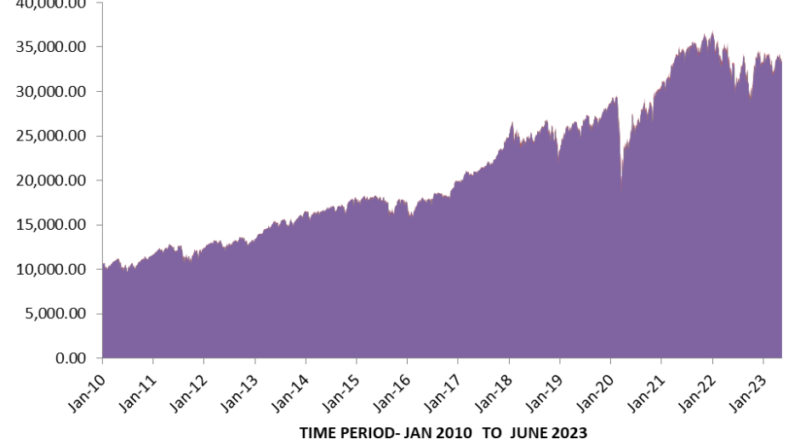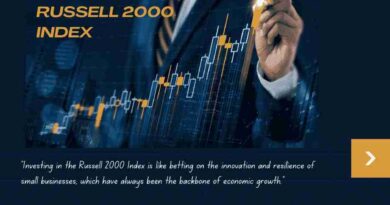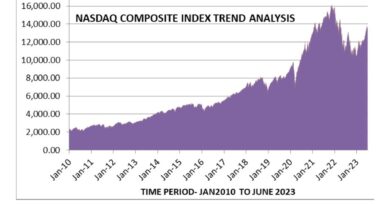Dow Jones Industrial Average: A Barometer of Market Health
Introduction
The Dow Jones Industrial Average, commonly known as the Dow Jones or the Dow, stands as one of the most renowned and closely monitored stock market indices worldwide. Since its establishment in 1896, it has served as a vital indicator of the overall health and performance of the U.S. stock market.
The Dow Jones Industrial Average holds a prominent position in the realm of financial markets, capturing the attention of investors, economists, and analysts alike. Its enduring legacy and reputation make it an essential barometer for evaluating market trends and measuring the pulse of the economy.
Historical Background
The historical background of the Dow Jones Industrial Average is rooted in the late 19th century, a time of rapid industrialization and economic growth in the United States. It was during this transformative period that two individuals, Charles Dow, and Edward Jones, came together to create an index that would serve as a reliable measure of stock market performance.
In 1896, Dow, in collaboration with Edward Jones, introduced the Dow Jones Industrial Average. At its inception, the index consisted of 12 large industrial companies, including names such as General Electric, American Tobacco, and U.S. Leather.
The index has changed over time in response to changes in the financial markets and changes in the macroeconomic environment. Beyond simply industrial businesses, the index has grown through time to encompass a wider spectrum of industries. This expansion is an outcome of the American economy’s changing structure and the rising importance of sectors like technology, finance, and healthcare.
The index gained popularity as it grew in size and impact, being widely recognized in the United States as well as abroad as an indicator of the performance of the stock market. The index committee of S&P Dow Jones Indices carefully chose the 30 significant publicly traded firms that make up the Dow Jones Industrial Average today. These 30 businesses, which represent some of the biggest and most powerful American enterprises, are regarded as blue-chip stocks.
Composition of Dow Jones Industrial Average
The Dow Jones Industrial Average currently consists of 30 major publicly traded companies. These companies are selected by the index committee of S&P Dow Jones Indices, a leading provider of financial market indices. The committee’s primary objective is to ensure that the index represents a cross-section of the U.S. economy and accurately reflects market performance.
The constituent companies of the Dow Jones Industrial Average are subject to occasional changes. When a company is no longer deemed representative of its industry or is undergoing financial instability, the committee may opt to replace it with another more suitable company. These changes help ensure that the Dow Jones remains relevant and aligned with the evolving economic landscape.
Calculation Methodology
The calculation methodology of the Dow Jones Industrial Average involves a price-weighted formula that reflects the stock price performance of its constituent companies. The process can be summarized in the following steps:
- Selection of Constituent Companies: The Dow Jones Industrial Average consists of 30 major publicly traded companies that are carefully selected by the index committee of S&P Dow Jones Indices. The committee aims to include companies from various sectors to represent the broader U.S. economy.
- Determination of the Divisor: The divisor is a crucial component of the Dow Jones calculation methodology. It is initially determined by dividing the sum of the stock prices of the 30 constituent companies at the time of the index’s inception. The divisor is adjusted periodically to account for events such as stock splits, dividends, and corporate actions.
- Calculation of the Index Value: To calculate the Dow Jones Industrial Average, the stock prices of the 30 constituent companies are added together. The sum is divided by the divisor. The resulting quotient represents the value of the index.
It’s crucial to remember that the index does not account for elements like market capitalization or the relative importance of specific companies. Instead, attention is being paid to changes in the stock prices of the constituent companies.
For example
Let’s consider a simplified scenario with three hypothetical companies: Company X, Company Y, and Company Z. The stock prices of companies X, Y, and Z are $50, $100, and $75, respectively.
To calculate the Dow Jones Industrial Average in this scenario, we add the stock prices together: $50 + $100 + $75 = $225. Suppose the current divisor is 0.25. Dividing the sum of the stock prices ($225) by the divisor (0.25) gives us an index value of 900.
If the stock price of Company Y increases to $120, while the stock prices of Company X and Company Z remain the same, the new sum of the stock prices would be $50 + $120 + $75 = $245.
To calculate the new Dow Jones Industrial Average, we divide the new sum of the stock prices ($245) by the same divisor (0.25). This results in an index value of 980.
In this example, the $20 increase in the stock price of Company Y led to an 80-point increase in the Dow Jones Industrial Average.
Significance of Dow Jones Industrial Average
The Dow Jones Industrial Average holds significant importance in the realm of finance and serves as a crucial indicator of the health and performance of the U.S. stock market. Its significance can be observed in several key areas:
- Market Performance: As one of the oldest and most widely recognized stock market indices, the Dow Jones Industrial Average acts as a benchmark for evaluating overall market performance. It provides investors, analysts, and economists with a snapshot of the market’s direction and trend. Changes in the Dow Jones often capture the attention of market participants and can influence investor sentiment and market behavior.
- Economic Barometer: The Dow Jones Industrial Average is closely linked to the broader economy. It reflects the performance of key industries and sectors, offering insights into economic growth and activity. As a price-weighted index, it emphasizes the performance of higher-priced stocks, which are often indicative of larger, more established companies. Fluctuations in the index can indicate shifts in investor confidence and overall economic conditions.
- Investor Sentiment: The movements of the Dow Jones Industrial Average can have a significant impact on investor sentiment. When the index reaches new highs, it may signal optimism and encourage investment activity. Conversely, downturns or volatility in the index can create uncertainty and lead to cautious investor behavior. The Dow Jones serves as a barometer of market sentiment and can influence investment decisions.
- Investment Strategy: The Dow Jones Industrial Average is used as a reference point for various investment strategies. Some investors may aim to replicate the performance of the index by investing in exchange-traded funds (ETFs) or mutual funds that track the Dow Jones. Additionally, Dow Jones can guide investors in identifying trends and opportunities within specific sectors or industries represented in the index.
- Global Impact: The Dow Jones Industrial Average has a global reach and is closely monitored by investors and market participants worldwide. It serves as an indicator not only of the U.S. stock market but also has implications for global financial markets. Changes in the Dow Jones can influence investor sentiment and trading activity in other markets, making it a crucial point of reference for international investors.
- Media and Public Perception: The Dow Jones Industrial Average receives extensive media coverage, making it a widely recognized symbol of stock market performance. News outlets report on daily movements, milestones, and major fluctuations in the index, which can impact public perception and confidence in the economy. The Dow Jones has become ingrained in popular culture and is often associated with broader economic well-being.
Limitations and Criticisms
While the Dow Jones Industrial Average is a widely followed and influential stock market index, it is not without its limitations and criticisms.
- Limited Representation: The Dow Jones Industrial Average consists of only 30 constituent companies, which is a relatively small sample compared to other indices like the S&P 500, which includes 500 companies. This limited representation may not accurately reflect the overall performance of the broader market or capture the diversity of industries and sectors. As a result, the Dow Jones may not provide a comprehensive view of the U.S. economy.
- Price-Weighted Calculation: The Dow Jones follows a price-weighted methodology, meaning that higher-priced stocks have a more significant impact on the index’s value, regardless of their market capitalization or the company’s overall size or influence. This can lead to distortions, as a price change in one high-priced stock can heavily influence the index’s movement, even if it represents a small portion of the overall market.
- Exclusion of Small and Mid-Cap Companies: The Dow Jones Industrial Average primarily includes large, well-established companies known as blue-chip stocks. This focus on larger companies excludes smaller and mid-cap companies, which can be important contributors to the overall economy and may have different growth prospects. By not including these companies, the Dow Jones may not fully represent the dynamics of the entire stock market.
- Lack of Sector Representation: While Dow Jones attempts to cover a range of sectors, its composition is not as diversified as other indices. It may not adequately represent certain industries or sectors that are significant contributors to the economy. This can limit its usefulness for investors who want sector-specific insights or exposure.
- The inflexibility of Constituent Companies: The Dow Jones Industrial Average undergoes periodic changes to its constituent companies, but the process of adding or removing companies is relatively infrequent. This inflexibility can result in outdated representation, as the index may not reflect the emergence of new industries or the decline of others in a timely manner.
- Overemphasis on Price Movements: The price-weighted calculation methodology places undue emphasis on stock price movements, rather than considering other factors such as market capitalization or the relative importance of companies. This can lead to a skewed representation of the overall market, as changes in stock prices may not necessarily reflect a company’s overall financial health or influence on the economy.
- Lack of International Exposure: The Dow Jones Industrial Average focuses solely on U.S.-based companies, which limits its ability to capture global market dynamics. In an increasingly interconnected and globalized world, the exclusion of international companies may restrict its relevance for investors seeking a broader perspective.
Final Takeaway
The Dow Jones Industrial Average is a prominent figure in the financial world and a crucial gauge of the health of the American stock market. Its historical context, the inclusion of 30 big corporations, and its special price-weighted calculation methodology all add to its notoriety and sway. Nevertheless, it is critical to recognize the index’s shortcomings and detractors.
Its accuracy and relevance may be impacted by the Dow Jones Industrial Average’s restricted representation, price-weighted computation, exclusion of small and mid-cap companies, and inflexibility in constituent revisions. Additionally, its inability to accurately reflect the complexity of the contemporary financial scene is hampered by its reliance on stock price fluctuations and lack of international exposure.
Despite these shortcomings, the Dow Jones Industrial Average is an effective tool for evaluating market performance, analyzing investor sentiment, and offering an overview of the American economy. For investors, analysts, and the general public, it acts as a well-known benchmark and reference point.



